I Dig Sports
The Pathirana question, Afghanistan's rustiness, the spin battle, and more
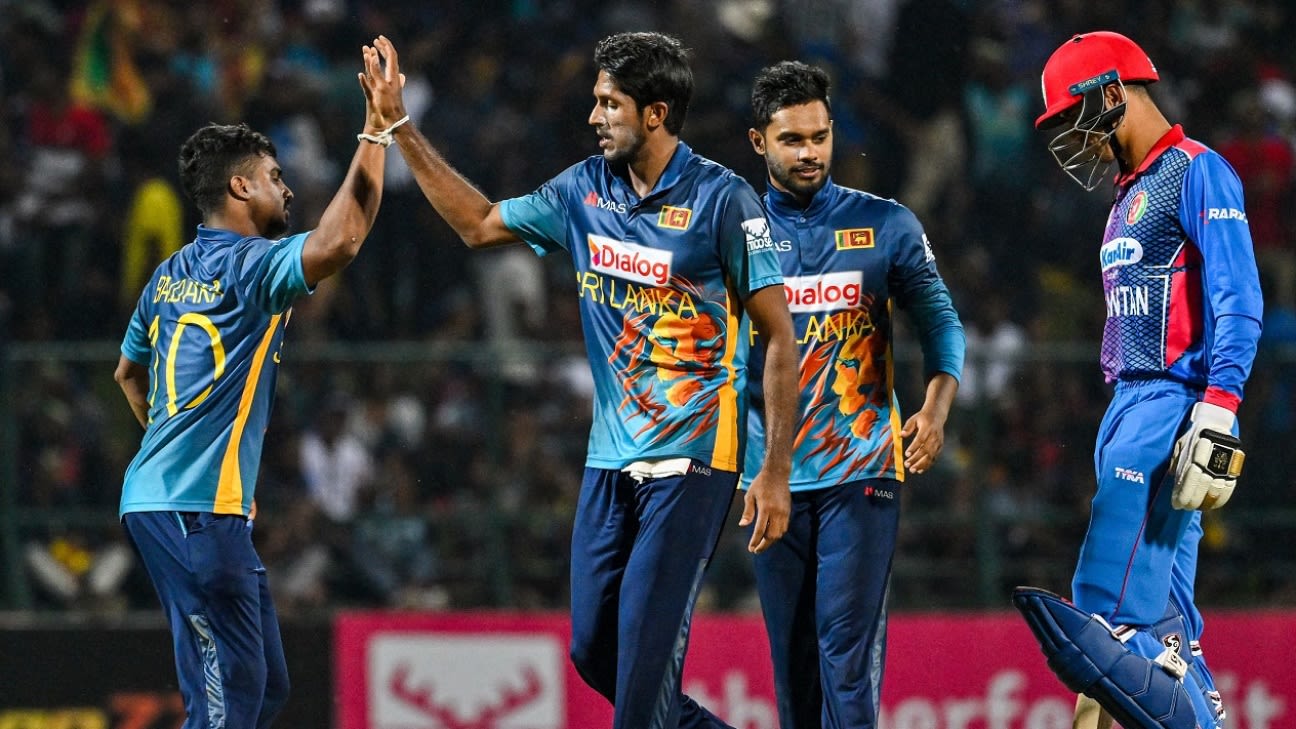
The Afghanistan men's side are going to the big show, but Sri Lanka are yet to qualify.
It is a testament to Afghanistan's rise - despite major challenges - and to Sri Lanka's ODI collapse, that they meet in Hambantota as evenly-matched outfits. For Afghanistan, this is their first serious preparation for the World Cup in October-November. Sri Lanka, meanwhile, must get their one-day game in gear ahead of the World Cup Qualifiers in Zimbabwe, starting later this month.
Here are some things to look out for in this three-match series.
Will Afghanistan be rusty?
How will the spinners fare?
Spinners will, however, have to contend with the furious crosswind that tends to blow in Hambantota. Usually, this means they tempt the batters to play their big shots into the wind.
Is Pathirana ready for internationals?
However, such is the hype around him at present that Sri Lanka may want to try him out. But is he ready for this format? And in matches where there is no Impact Player substitution - like it was in IPL - can he reliably deliver new-ball overs?
Can both teams finish their batting innings better?
Since 2021, Sri Lanka have scored at a run rate of only 6.97 in the last ten overs of an ODI innings. A whopping 39% of the deliveries they have faced in that portion have been dot balls. Clearly, there is a lack of firepower lower down in the middle order, with Dasun Shanaka only sporadically effective, and the likes of Chamika Karunaratne and Hasaranga possessing limited hitting ability.
Perhaps the thinking with bringing Dimuth Karunaratne back is that Sri Lanka will conserve wickets through the innings better, and have the likes of Angelo Mathews, Dhananjaya de Silva or even Charith Asalanka at the crease towards the close.
Afghanistan, meanwhile, have been only slightly better in the last ten since 2021. They have scored at 7.18, with almost 39% of deliveries faced also being dots. Rashid has been their standout finisher in that time.

With light nights and warmer weather now with us, it’s the perfect time to venture off the beaten track and here are some of the latest shoes to help you explore your local trails
VJ – Ultra 2 – £145.00
Using 4mm deep butyl rubber studs for exceptional traction, it’s no wonder the brand claim to offer the best grip on the planet!
On a variety of surfaces from grass to gravel to rock and in varying conditions, we couldn’t put a foot wrong in these shoes. Straight from the box, the sole feels almost sticky to the touch and particularly on wet rock, which is usually the strongest test for this type of off-road shoe, the shoe excels with a surefootedness beyond compare.
VJ Ultra 2
Now offering more stability thanks to a slightly wider footprint, the shoe also features a rock plate to protect against the harshest underfoot conditions.
Durability is excellent thanks to the Kevlar woven upper which is now lighter and softer but still features protective overlays all around the foot. The brand’s Fitlock system is a broad band incorporated into the medial side of the upper which wraps under the arch of the foot and adds to the support and secure fit of the shoe.
For an unrivalled grip and great durability, it’s a shoe that goes the distance.
Mizuno – Wave Mujin 9 – £140.00
A little lighter than the previous version, the Mujin 9 still retains the key features that make it a great off-road option.
The cleverly engineered multi-directional pattern of the Michelin rubber outsole provides excellent traction, stability, durability and adaptability on a variety of surfaces. Now 12mm wider across the forefoot footprint, the shoe feels more planted on the trail, adding to the feel of stability and improved traction.
Mizuno Mujin 9
The dual-layer midsole is made up of the brands U4ICX and Enerzy cushioning foams. Combined they give a nice feel of cushioning and stability without being overly soft. This helps retain the sensation of being closely connected to the trail for a confident footing.
TPU support straps incorporated into the heel area of the shoe help create a secure and supportive fit, adding to the stable ride and making this a versatile off-road option.
ASICS – Gel Trabuco 11 – £145.00
An excellent door-to-trail option, the Trabuco feels very much like a highly cushioned road shoe with an off-road outsole.
The FF Blast cushioning with a Gel insert in the heel really does soak up the impact and makes this a shoe that could cover many miles on any surface. There’s 2mm more cushioning under the forefoot than the previous version as well as a rock plate to prevent sharp stones from penetrating it on harsh terrain.
ASICS Trabuco
The breathable mesh upper again has a road-like feel, so it feels comfortable from the first step inside. Added protection around the toe keeps the undergrowth at bay and aids durability.
For max off-road cushioning, it’s a great choice.
INOV-8 – Trailfly G270 v2 – £150.00
With a lab-tested more durable upper, the G270 is made to go the distance.
A zero drop, 12mm stack of cushioning gives it a connected feel of the ground making it easy to move quickly across unpredictable terrain. While that 12mm sounds a little low, it does a great job of cushioning by using the brand’s Powerflow Max foam combined with their Boomerang footbed (a super-soft and almost springy insole).
INOV-8 Trailfly G270v2
The 4mm deep Graphene lugs provide traction which proves to be exceptionally durable. As with all the brand’s shoes the number (in this case 270) indicates the weight of the shoe. At 270 grams it is light thanks to a great wraparound fit it disappears on the foot and feels even lighter on the move.
It’s a great option for moving fast across uneven ground thanks to the low stack yet cushioned feel.
Nike – Pegasus Trail 4 GTX – £144.95
One of the most popular road running shoes of all time with a waterproof upper and go-anywhere sole, is this the perfect trail shoe?
Well, it certainly ticks a lot of the boxes. The React foam cushioning is a little different from the road-going Pegasus but here proves to be light and more importantly durable. Combined with an outsole design that provides good traction when both descending and ascending steep trails, the underfoot performance is great.
Nike Pegasus Trail
Gore-Tex invisible fit waterproofing is a welcome addition if you happen to encounter a slightly larger than usual puddle of even long wet grass as it keeps your feet warm and dry.
Ultimately a very easy to get on with multi-use shoe with great step-in comfort that remains wherever you venture.
Brooks – Catamount 2 – £160.00
Whereas the original Catamount felt more like a trail racer, this update gives the shoe a wider appeal and more versatility thanks to a deeper stack of cushioning. It’s the brand’s DNA Flash midsole used in this shoe, a nitrogen-injected material that offers a light, cushioned and highly responsive ride, it’s also very durable as we’ve found out in the brand’s Glycerin road running model.
Brooks Catamount
A Skyvault propulsion plate is embedded into the midsole and although the shoe does feel responsive the plate serves more to add protection from sharp rocks. The TrailTack rubber offers ‘sticky’ traction on rocks but also serves well across a variety of surfaces.
The clever dual-sided mesh upper has an abrasion-resistant outer side and a soft, quick-drying inner and is put together to the same high standard we’ve come to expect from Brooks.
For the feel of a responsive road racer in an off-road model, it’s a great choice.
Saucony – Peregrine 13 – £130.00
The most established trail shoe in our line-up, the 13th edition of the Peregrine continues to offer a great blend of cushioning and grip in a shoe that seems to become more comfortable with each update.
The 28mm stack of PWRRUN foam provides road-shoe-like levels of cushioning but when combined with the brand’s PWRTRAC outsole, the aggressive grip transforms it into an off-road shoe capable of taking on the harshest terrain. Despite the deep 28mm stack height, the shoe remains super-light at just 260g, so it never feels heavy, even when wet.
Saucony Peregrine 13
The upper is light, breathable and soft around the foot but with added protection around the toe bumper where you’ll need it most.
It’s a competitively priced option that you can confidently venture off the beaten track in.
Merrell – MTL Skyline 2 – £170.00
At just 198g, this shoe is the lightest in this line-up. It’s most definitely a trail racer rather than an everyday off-road shoe and is designed for moving fast.
Compared to many of the other shoes featured here it’s a more minimal affair, with low-profile cushioning encasing a FlexPlate. This plate acts to add stability and protection as well as provide a responsive toe-off. Despite not being carbon, it does give a nice spring-like effect but that’s only noticeable on firmer surfaces.
Merrell MTL Skyline 2
The outsole uses Vibram Metagrip and features large cut-away sections to keep weight down and aid flexibility. It has 5mm deep lugs that provide great grip in wet and dry conditions.
The upper is more akin to that of a road racing shoe, super lightweight, again making this best for race day than the more demanding requirements of everyday off-roading.
The North Face – Summit Vectiv Pro – £225.00
Aimed perhaps more at ultra-distance trail races such as the UTMB, the Vectiv Pro offers high stack cushioning and a carbon-fibre plate usually seen on top-end road racers.
The 33mm stack of foam and deep rocker offers the feel of a road shoe along with the now familiar carbon-plate toe-off effect. Combined with the 3.5mm outsole lugs we have a package that can cover long distances with a propulsive feel for mile after mile on rugged terrain.
TNF Summit Vectiv Pro
The shoe copes well with gravel and firmer trail surfaces for which it is aimed more so than muddy paths and tracks. But as always with trail shoes it’s ‘horses for courses’ on in its intended habitat the shoe excels.
A light, breathable mesh upper is again suited to warmer weather but it’s much more durable than it first appears. For ultra-events the cushioning and feel keep on going mile after mile.
ITTF President Elected as ASOIF Council Member

Petra Sörling, President of the International Table Tennis Federation, was elected to the Association of Summer Olympic International Federations (ASOIF) Council this week at the umbrella body’s General Assembly.
“I cannot thank the members of ASOIF enough for entrusting me to help lead the organisation,” Sörling said in a statement.
“I am truly honoured and humbled to be elected as a Council member of the ASOIF. It is a privilege to serve alongside esteemed colleagues in shaping the future of international sports governance. I am committed to upholding the values of the Olympic Movement.”
“For forty years ASOIF has been integrate in advocating for member federations in the Olympic Movement, and I am excited to join that legacy. With the 2024 Olympics in Paris less than two years away, there is much to be done in preparations to ensure they are the best Olympic Games ever.”
This is the first time an ITTF representative is sitting on the ASOIF Council. The ITTF nominated Ms. Sörling after she was elected the first ever female president of the federation and her work advancing sustainability and gender equality in her sport.
The ASOIF Council, a governing body of the ASOIF, consists of a President and six Members, each representing different Federations. Ms. Sörling succeeds International Triathlon Union President Marisol Casado who has finished her final term. Ingmar De Vos (International Equestrian Federation), Morinari Watanabe (International Gymnastics Federation) were re-elected for a second term of office as Council members.

Club Leon earned a 2-1 victory at home over LAFC in the first leg of the CONCACAF Champions League final on Wednesday.
LAFC forward Denis Bouanga scored in the 96th minute a key goal for the MLS club for the decisive second leg scheduled for Sunday night in Los Angeles.
- Stream on ESPN+: LaLiga, Bundesliga, more (U.S.)
In a packed Estadio Leon, the hosts play for the first time in three weeks after being eliminated in the first round of the Liga MX playoffs.
Leon had to make early changes when Colombian midfielder Yairo Moreno suffered an injury in the eighth minute, forcing a substitution that brought in Elias Hernandez. Seconds later and following a corner from winger Angel Mena, Leon brushed away any worries with a well-placed header and goal from defender William Tesillo.
Led by the high-pressing tactics of manager Nicolas Larcamon, Leon did an excellent job throughout the first half by containing the visiting opposition in their own end of the pitch.
During injury time and shortly before the break, Los Panzas Verdes were later given an opportunity to extend their lead after a handball in the 18-yard box from LAFC defender Ryan Hollingshead. Confirmed as a penalty after a review from VAR, Mena then made it 2-0 in the 50th minute after scoring from the spot.
After halftime, LAFC began to gain much-needed momentum.
Stealing more of the possession, the MLS side tested Leon's backline that started to collect blocked shots and interceptions.
Leon did well to halt most of what LAFC's attacking players were throwing at them in the second half, but just seconds before the end of the match, the visitors earned a valuable last-minute goal from Bouanga. Connecting with a cross from substitute Mateusz Bogusz, Bouanga slotted the ball into the back of Leon's net, thereby keeping LAFC very much alive in the series.
Moments later, the final whistle blew, giving Leon a bittersweet 2-1 win.
On Sunday, LAFC will host the second leg of the CONCACAF Champions League at BMO Stadium. Neither team has ever won this competition.
The away-goals rule, utilized in each round of the competition, is not being used in the final. If the aggregate score is level after 90 minutes on Sunday, the teams will play 30 minutes of extra time, then go to penalty kicks if necessary.
In the previous 2022 edition, the Seattle Sounders became the first MLS club to win the CONCACAF tournament since the beginning of the "Champions League" era in 2008 and the team that ended a 13-title streak for Liga MX clubs.
Information from Reuters was used in this report.
Ben Stokes reaps rewards of IPL gymwork after playing the 'John Terry role' at CSK
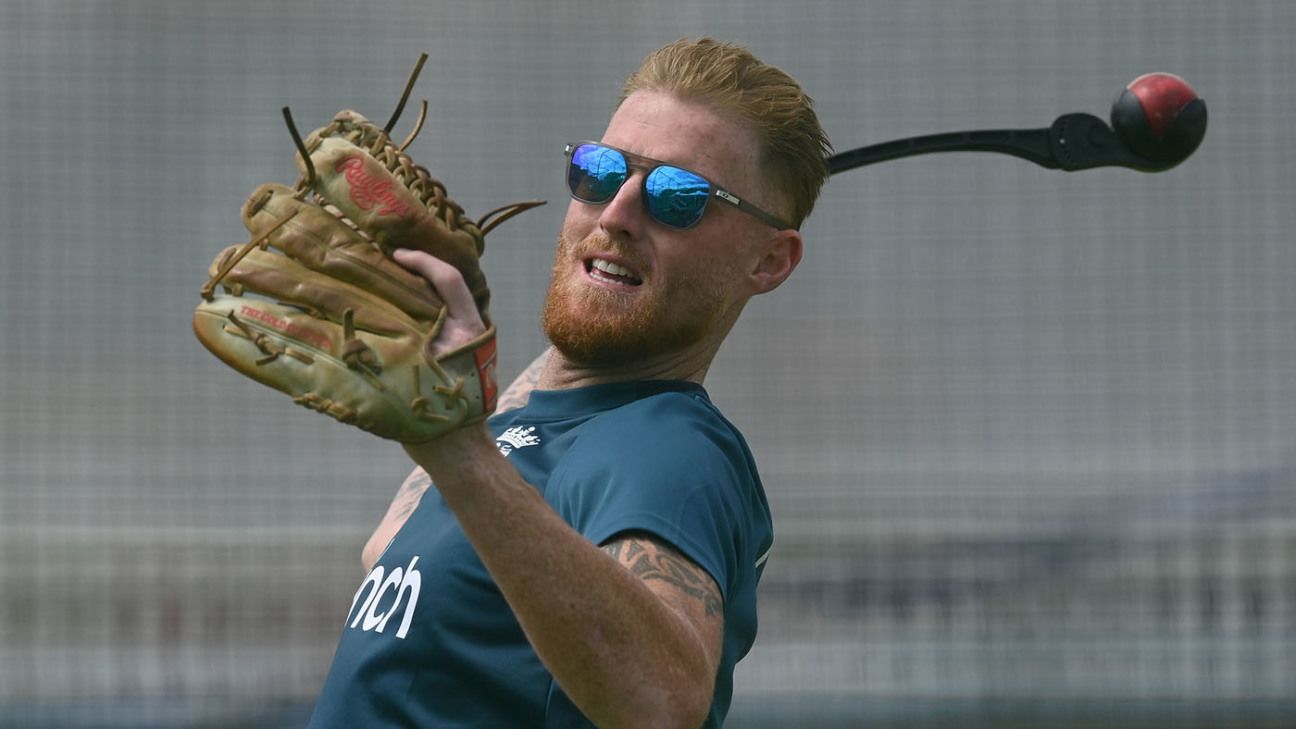
Stokes has been back in the UK for two weeks and watched the Ravi Jadeja-inspired victory over Gujarat Titans on his phone in the bar of the Royal Garden Hotel in Kensington, where England are staying for the Ireland Test. He will likely bag a win bonus, too, and any other extras the owners wish to bestow upon the playing group after a fifth IPL title.
Perhaps Ledley King would be a more accurate England centre-back to draw parallels with, considering where Stokes is at right now. A Tottenham Hotspur legend, King was blighted by issues to his left knee throughout his career, not too dissimilar to what the Test skipper has been dealing with since 2017. King managed his issue by limiting training between games. Stokes is following suit.
Taking cues from the 40-year-old James Anderson, Stokes has opted to limit his bowling between Tests. He has not bowled at all this week, believing there are a finite number of overs left in a body with much more than its 31 years on the clock.
"Before I didn't have to worry about that," he said on Wednesday. "I could just bowl and bowl and bowl and turn up pretty fresh. Now I'm probably not able to do that, so in between games is probably the most important bit of managing anything correctly.
"The thing about me is that I don't need much bowling for the rest of my body to tick over. I can have quite a lot of time off and then build up quite quickly. It's not doom and gloom if I do or don't bowl in this game."
Nevertheless, he declares himself fit enough to bowl at Lord's if required and to send down however many overs required of him throughout the Ashes, too. Even at face value, it is a huge improvement in attitude above all else. He was deflated by his knee at the end of February after the New Zealand series, and that in turn was affecting his batting. To go by his net sessions this week, that is no longer the case.
There had been fears before his IPL stint that Stokes would return from India more broken than before, but those did not eventuate. Instead, the lack of playing time meant he ended up using the world's premiere T20 competition as a glorified training camp.
"I think I would much rather have been playing," Stokes said. "I've then seen that as an opportunity to train as opposed to playing and then topping yourself up as the tournament goes along. Once you get into the tournament it's like play, travel, all that kind of stuff. So, I was actually able to turn a disappointing situation into a positive one because I was able to concentrate on properly being able to train, whether that be technical stuff with the bat or fitness stuff, stuff in the gym and being able to concentrate on something else.
"And that was a really good way to get through that long period of having something else to focus on, as opposed to being disappointed I wasn't playing. So looking back on it, you might say it's disappointing to only play two games but I was able to then do something else. Sitting here today, I'm actually thinking it could have been a blessing in disguise - every cloud has a silver lining."
The work put in is noticeable. Though you'd never say he was overweight - certainly not to his face - Stokes' more pronounced cheekbones suggest he's back to the sort of lean figure that marked his stellar year in 2019. Considering a bowler of his pace will put around eight times his body weight through that troublesome left knee at the moment of delivery, it will help him deliver as a functional allrounder this summer.
Given the game's direction of travel, you might regard Stokes' use of the IPL as a training camp as a crass victory for the diehard traditionalists, though only a player of his stature has the privilege to do such a thing. His lack of playing time will not have affected his stock with CSK, who have an eye on him leading them in the future when MS Dhoni decides to call time. But they may think twice about extending it on the same terms in 2023.
To have arrived back primed for the red ball, even in lieu of a run-out in the County Championship for Durham, means Stokes is something of an outlier, albeit a very specific one given his situation. Ahead of a home season in which the longest format is considering its very existence, as franchise competitions multiply and encroach on previously sacred turf, Stokes - a self-proclaimed "huge advocate of the Test format" -acknowledges both codes are up against each other. Though not necessarily in a bad way.
"The whole landscape and the whole game of cricket is literally just changing in front of everyone's eyes so quickly. I see T20 and Test cricket being able to keep being successful and progress side by side.
"Look at what T20 has done for the game in general, the amount of attraction it's brought, new fans, new players it's brought into playing cricket regardless of the format. And also what T20 has been able to bring in terms of Test cricket. The transition between the two games is so different but at certain periods in Test matches you do see that T20 side come out, which is only because the players have been playing it. So, I don't see a world where T20 and Tests aren't being played in the future."
He cedes that commitment to a brand of cricket reliant on ignoring risk and blue-ticking fear may be a little trickier given the excitement around the five-Test series against Australia just around the corner.
"It's hard to ignore and not see," he said of the anticipation. "I don't know what this build-up period before the Ashes is like compared to 2005, no idea, it's very hard to ignore and not be able to see the excitement."
It is Ireland first, however. A one-off four-day fixture even the visitors regard as a distraction given their own bigger carrot of June's World Cup qualifiers in Zimbabwe. A reminder that whatever trepidation there may be of the new world, the old one was far from equal.
Vithushan Ehantharajah is an associate editor at ESPNcricinfo
French Open 2023: Iga Swiatek continues title defence; Casper Ruud, Elena Rybakina also in action
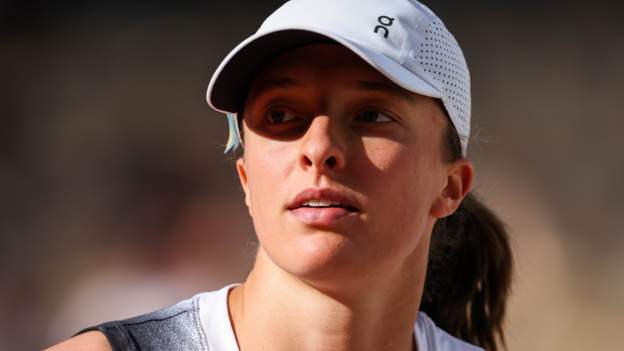
Defending champion Iga Swiatek says she is not concerned by records as she continues her bid for a third French Open win in four years.
The Polish world number one faces American Claire Liu in the second round on Thursday.
A third title would see her equal Serena Williams and Monica Seles' record at Roland Garros, but such numbers do not interest Swiatek.
"I don't even know these records," the 21-year-old said.
"I play tennis but I'm not really an expert in terms of statistics and history, so I'm not really focused on that.
"I never even played Serena or Monica Seles. I'm kind of living my own life and having my own journey."
Top-10 seeds Ons Jabeur of Tunisia, Kazakh Elena Rybakina and American Coco Gauff will feature during the day on Thursday.
However, the night session features a men's singles for the fourth time in five days with former semi-finalist Alexander Zverev taking on Alex Molcan.
Danish sixth seed Holger Rune's match against home favourite Gael Monfils had initially been scheduled for the late session on Court Philippe Chatrier, but Monfils withdrew on Wednesday with injury, handing Rune a walkover.
Last year's runner-up Casper Ruud and Italian eighth seed Jannik Sinner are also in action on the fifth day.
Night sessions remain under scrutiny
The night sessions, promoted as the highlight of the day at a major, have yet to feature a women's match.
The tournament was heavily criticised last year when only one of the 10 night session matches involved a female player, and director Amelie Mauresmo said in May that she could not promise there would be an equal share of men's and women's matches in the future.
Thursday's line-up includes Grand Slam champions Swiatek and Rybakina as well as crowd favourite Jabeur, but Zverev will take on Molcan on the showcourt after Monfils pulled out with a wrist problem.
"I'm on the player council, and we've had a lot of conversations about this, and we've had a lot of conversations about equality," American Sloane Stephens, speaking before Thursday's schedule was announced, said.
"Four out of four men's matches. That's not what we talk about. That's not what we're about. So there's really not much to say about it."
The French Open is the only Grand Slam to have one match during the night session rather than two.
Stephens also pointed to the way a night match can affect conditions on the Paris clay.
"Every single time I've played here, my last - I don't even know how many French Opens I've played - there hasn't been a night match," she added.
"I think it kind of completely changes the dynamic of the tournament in itself. But nobody asked me for advice on what they should do, so it's their tournament. They do as they please."
Who else plays on Thursday?
In a stacked women's draw, Australian Open runner-up Rybakina faces talented Czech Linda Noskova.
Sixth-seeded Gauff plays Austrian Julia Grabher and seventh seed Jabeur faces France's Oceane Dodin as both seeds bid for a first major singles title.
Norway's Ruud takes on Italian Giulio Zeppieri while Sinner, another of the favourites for the title, faces German Daniel Altmaier on Court Suzanne Lenglen.
In the men's doubles Britons Jamie Murray and Lloyd Glasspool are in second-round action.
Fifth seeds Glasspool and Finland's Harri Heliovaara take on Belarusian Ilya Ivashka and Australian Alexei Popyrin.
Murray and New Zealand partner Michael Venus, the 13th seeds, face Colombian duo Juan Sebastian Cabal and Robert Farah.
Elsewhere, Dutchman Jean-Julien Rojer and Argentine Marcelo Arevalo, the defending champions, meet Nicolas Barrientos of Colombia and American Robert Galloway.
French Open 2023: Novak Djokovic stands by Kosovo message after criticism
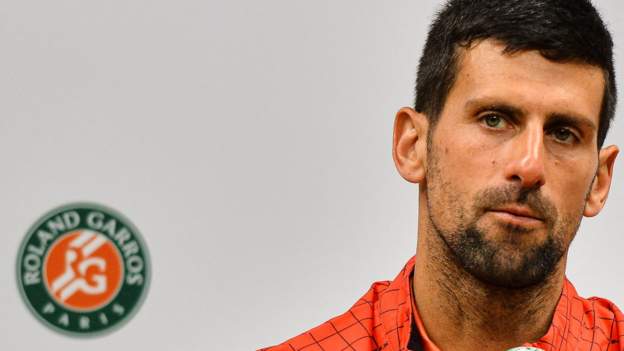
Novak Djokovic says he is "aware people would disagree" with him writing a political message about Kosovo on a French Open camera lens but it is an issue he "stands for".
Djokovic, 36, wrote "Kosovo is the heart of Serbia. Stop the violence" after his first-round win on Monday.
France's sports minister said the Serb's actions were "not appropriate" and should not happen again.
"A drama-free Grand Slam, I don't think it can happen for me," said Djokovic.
"I guess that drives me, as well."
The phrase Djokovic wrote is in reference to recent tension in Kosovo, which declared independence from Serbia in 2008. Serbia has never recognised Kosovo's independence.
There has been violence in the past days following the installation of ethnic Albanian mayors in the north of the country, with police and Nato troops clashing with Serb protesters.
In his post-match news conference, the 22-time Grand Slam champion attempted to put the controversy behind him.
Asked if he had thought about the negative reaction to his actions, Djokovic said: "Of course I'm aware that a lot of people would disagree, but it is what it is. It's something that I stand for. So that's all."
After beating Hungary's Marton Fucsovics in the second round on Wednesday, Djokovic marked the lens - which the winner does after every French Open match - with his signature.
World governing body the International Tennis Federation said Djokovic's statement did not violate any rules because the Grand Slam rulebook does not ban political statements.
French sports minister Amelie Oudea-Castera said there needs to be a "principle of neutrality for the field of play".
Oudea-Castera said she made a distinction for messages in support for Ukraine in the face of Russia's invasion, adding that she did not put Kosovo and Ukraine "on the same level".
That includes supporting Ukrainian player Marta Kostyuk, who was booed by the crowd after she refused to shake hands with Aryna Sabalenka of Belarus on Sunday.
Belarus is an ally of Russia and allowed troops to use its territory to launch last year's invasion of Ukraine.
Djokovic, whose father was born in Kosovo, said earlier in the week he was "against wars, violence and any kind of conflict" but that the situation in Kosovo is a "precedent in international law".
"Especially as a son of a man born in Kosovo, I feel the need to give my support to our people and to the entirety of Serbia," he said on Monday.
"Kosovo is our cradle, our stronghold, centre of the most important things for our country. There are many reasons why I wrote that on the camera.
"Of course it hurts me very much as a Serb to see what is happening in Kosovo and the way our people have been practically expelled from the municipal offices, so the least I could do was this."
Kosovo Olympic authorities have asked the International Olympic Committee (IOC) to open disciplinary proceedings against Djokovic, accusing him of stirring up political tension.
Djokovic's message 'bound to ruffle feathers'
Guy Delauney, BBC News Balkans correspondent
"Kosovo is the heart of Serbia" might seem like an odd statement. After all, Kosovo became independent in 2008 - and its geographical location in the south west meant that, even before then, it was always on the periphery of Serbia.
But its symbolic significance remains highly important to many Serbs. The 1389 Battle of Kosovo has been mythologised as the crucial event in the forging of Serbian identity. And many of the most important sites of the Serbian Orthodox Church are within modern-day Kosovo.
Serbia is one of scores of countries which refuse to recognise Kosovo's unilateral declaration of independence. And Serbians with family ties to Kosovo are particularly keen to ensure that Serbia's policy of non-recognition continues.
It has been a turbulent month for Serbia - with mass shootings and multiple protests - and ethnic-Serbs in Kosovo. By writing his courtside message, the country's sporting icon was showing his support - but in a way which was bound to ruffle feathers.
With his marker pen scribble, Djokovic neatly illustrated the enduring complexity of the situation.

In a recent Squash Mad article, Mike Dale rightly worried about “the decay of our sport at participation level’, writes Dan Regan.
Even squash writing and reportage are skewed, as is the case for other sports, toward professional and elite levels. Mine is a message to newcomers. What might attract recreational players? Here are some reasons—there are others—to take up the game.
Present orientation
“Squash is life,” wrote a local teaching pro on his website. No, it isn’t, at least not below elite or professional levels, and the remove from reality is part of its appeal. Players, when they step onto the court, create their own universe, putting their lives temporarily on hold. Closing the door to the court shuts everything else out.
Squash, engrossing and fast-paced, makes a radical demand on its participants to live in the present. You will have no time to think about anything except the task at hand: neither about work to be done nor errands to be run. Every player knows what happens when your mind wanders. Your opponent quickly reaches 11 before you can say “Let Point!”
Mental health experts and advice columnists exhort us to live in the present. Decent squash demands it.
Its intimacy
Squash is a particularly intimate sport. You are both, after all, in a small, enclosed space “on the same side of the net.” That intimacy demands a calibrated mixture of both conflict as well as cooperation. Without the latter, a flowing game is next to impossible.
The traffic problems around the T become insurmountable and the action no fun at all. Squash demands rivalry, aggression, and fierce competition, but also some degree of agreement, cordiality, and harmony.
You and your opponent—at sub-elite levels often termed, for good reason, a squash “partner”— are together responsible for co-creating a kind of happening or performance.
Squash: A global sport
You will be playing a truly global sport. Squash enthusiasts in my country, the US, are at least vaguely aware that the ball in use today superseded a harder, bouncier one in America. Less remarked upon is how remarkable a change that was. It occurred in the late twentieth century, when globalization was at its zenith.
So often the direction of globalization meant the export of North American cultural items: the McDonaldization of the world. Squash provided an exception to this pattern, a reversal of the usual globalization vector. Americans adopted what the rest of the (squash) world did, instead of the reverse. And what a bounty we reaped in return: a more beautiful and demanding game that paid increased dividends in fitness and fun.
Reward for proficiency
As you get better, your skill at striking the ball will improve, but so will your opponents’ retrieving abilities. The upshot is that rallies will get longer, which provides tremendous motivation to improve. Longer rallies contribute to an enjoyable sense of flow. Only occasionally do points end abruptly by an emphatic serve or return. While the serve and return are important, neither dominates, as they do in several other racket sports. Once the ball is in play, points have a chance to develop through extended rallies.
Mental challenges
Squash is a demanding physical game, but also a mental one. It will force you to navigate seamlessly across several areas of knowledge while unconsciously tackling an array of mental challenges. It is not too much to call squash a truly interdisciplinary activity.
The most basic shots, straight rails and crosscourts, make players quickly size up angles and intuitively perform calculations that are the equal of those on geometry exams. Boasts and shots into the nick demand even more complex reckonings. In the arcs traced by drives or lobs, finding a balance between pace, height, and distance is similarly critical.
These kinds of computations, performed on the fly, are those a physics instructor would recognize. The twin themes of conflict and cooperation are dear to any sociologist’s heart. Naturally, kinesiology comes into play, as squash tests several principles of fitness and movement science. Squash also incorporates elements from the arts—dance, for instance, in the intricate ballet of players around the T.
To this list of answers to “why squash?” we can add gender parity and the way squash, named “the healthiest sport in the world” multiple times by Forbes Magazine, provides an efficient workout. Even more, you get to play on a court that shares dimensions with those used by the pros. There is no need to fantasize about a Field of Dreams.
And these are all aspects of squash available to every player, not just those in the top echelons.
Dan Regan, a sociologist, is retired from teaching and academic administration, but not from the squash court.
Swansea 33-68 Barbarians: St Helen's lauds Alun Wyn Jones as Baa-Baas triumph
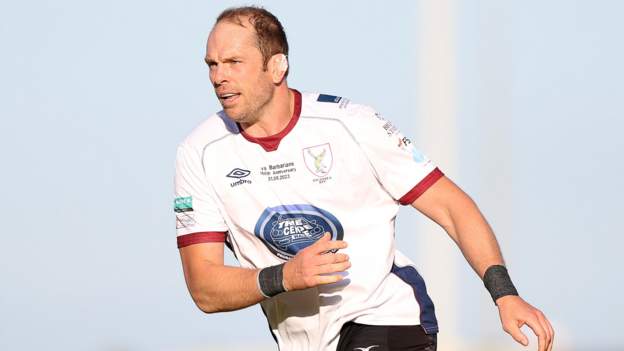
Alun Wyn Jones gave 6,238 fans a night to remember as he featured for both sides in Barbarians' 68-33 win over Swansea.
Three days on from his maiden Barbarians appearance against a World XV at Twickenham, Jones represented the Baa-Baas in the first half before donning the Swansea shirt after the restart, at the venue where he made his club debut against Carmarthen Quins 19 years ago.
The star-studded event saw the 37-year-old wear the Barbarians jersey for the final stages on what was a night to remember for the world's most-capped international.
The All Whites - celebrating their 150th anniversary - were full of confidence early on.
But Barbarians wasted no time in showing their superiority as Olly Robinson, Stephen Shingler and Taichi Takahashi all touched down inside the opening 15 minutes.
The bumper crowd - which included legendary Wales and British and Irish Lions prop Adam Jones, and ex-Wales fly-half James Hook - were on their feet midway through the first half as Swansea turned on the style to score their first points with a try from Joe Thomas.
John Mulvihill's side responded with a sublime score of their own through Tom Howe, before Hanno Dirksen hit back with another try for the hosts.
Howe notched his second try of the game in the final stages of the first half, which was played in jovial mood throughout, and typified by the celebrations of Bradley Davies - on his final career appearance - who raised his fist into the hot Swansea air upon hearing the stadium announcer's confirmation that beer tents had been replenished with stock ahead of half-time.
Jones re-emerged from the dressing room in the white jersey of Swansea, much to the delight of the crowd in attendance.
It ensured he was on the receiving end of Barbarians' quality in the second half as Damien Hoyland and Shingler both crossed the whitewash shortly after the restart.
Former Cardiff, Wasps and Ospreys lock Davies enjoyed his moment in the limelight by converting Rey Lee-Lo's try for the Baa-Baas.
On 52 minutes, St Helen's united in applauding Jones off the field as he prepared to watch the final stages from the comfort of the dugout.
Kirby Myhill notched Barbarians' ninth try before Brandon Wood, Matthew Aubrey and Willis Wood responded with efforts for Swansea.
Jones, on his homecoming, received another round of rapturous applause as he donned the Baa-Baas shirt for the final throes of the contest which ended with Myhill scoring his second try of the game, and Tonga international Elvis Taione amusing the crowd before adding the conversion.
Jones with 'a tear in his eye'
Davies admitted his fellow second row Jones had a tear in his eye after being caught up with the emotion of the 15-try thriller in Swansea.
"Alun Wyn's a fantastic player, he's had an amazing career and no one will ever achieve what he has," said Davies.
"It's mad because we were probably fighting for the same shirt for 15 years - he's taken about 200 caps off me!
"He's a good mate of mine and you can see what it means to him.
"Before the game he was upset, with a tear in his eye. He's a very passionate man but it was nice to see him have a proper send-off."
Davies stole the limelight late on as he converted a try just three days after Jones was unsuccessful from the kicking tee during Barbarians' dramatic 48-42 win over a World XV at Twickenham.
"We said all of the boys leaving had to have a shot," added Davies.
"I picked it tactically, as soon as there was one in front of the posts, I took the first one. As long as I beat Alun Wyn, I'm happy."
Davies added: "Rocking up here to St Helen's, full, with the crowd on the bank, a nice day - these are my memories of Welsh rugby.
"It was 100% a throwback. That's what we're missing. I'd watch Pontypridd versus Cardiff on Boxing Day any day of the week.
"We had more than 6,000 here today, a great family occasion. That's what we miss."
Swansea: Gareth O Rees; Brandon Wood, Joe Thomas, Osian Knott, Matthew Jenkins; James Davies, Gareth J Rees; Tom Sloane (C), Owen Thomas, Richard Murphy, Lloyd Ashley, Matt Dodd, Jay Williams, Callum Bowden, Joe Greaves.
Replacements: Garan Williams, Ed Thompson, Scott Jenkins, Chris Thompson, Sam Richards, Matthew Aubrey, Chris Morgans, Willis Wood, Hanno Dirksen, Tom Crockett.
Barbarians: Damien Hoyland; Taichi Takahashi, Rey Lee-Lo, Billy Twelvetrees, Alex Wootton; Stephen Shingler, Lewis Jones; Oli Kebble, Kirby Myhill, Enrique Pieretto, Bradley Davies, Alun Wyn Jones (C), Dan Lydiate, Olly Robinson, Sione Vailanu.
Replacements: Elvis Taione, D'Arcy Rae, Murray McCallum, Matthew Screech, Sam Cross, Harri Morgan, Lloyd Williams, Billy Searle, Tom Howe.
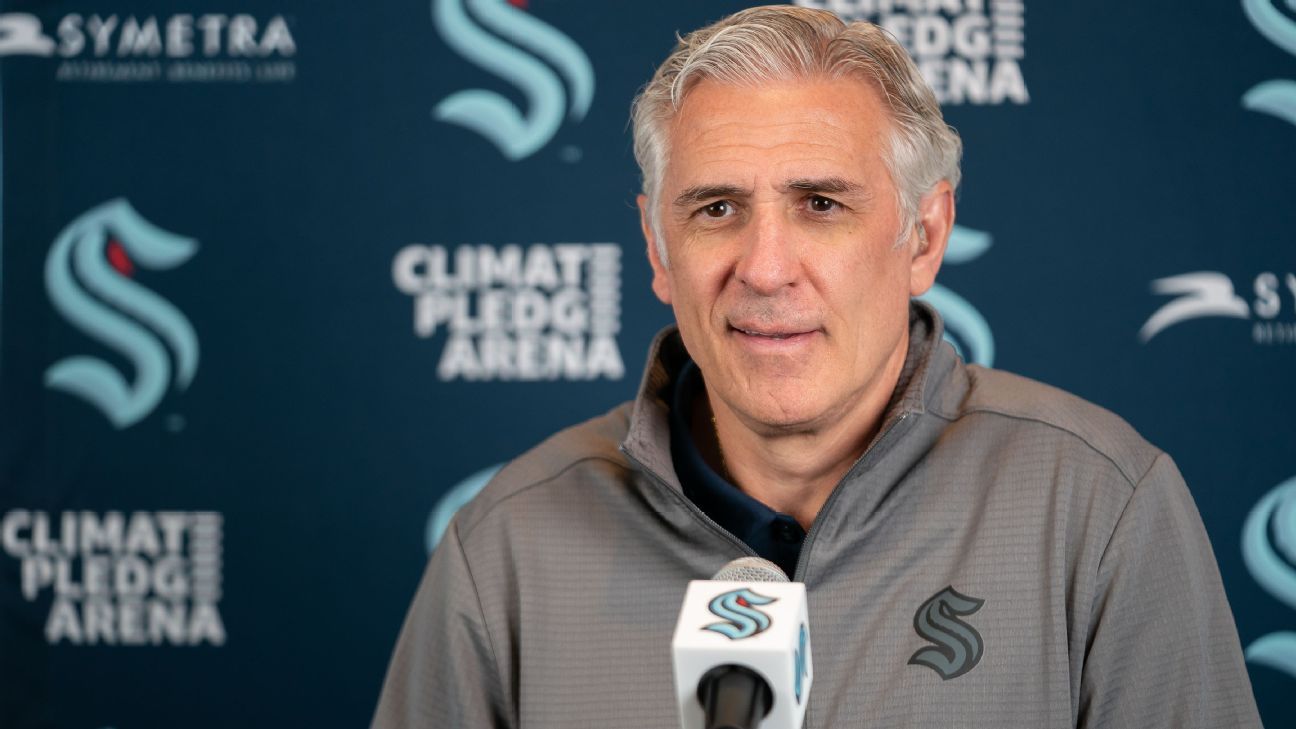
SEATTLE -- The Seattle Kraken signed general manager Ron Francis to a three-year contract extension Wednesday through the 2026-27 season after the franchise reached the second round of the NHL playoffs in its second year of existence.
Hired to be the first GM in franchise history, Francis navigated through a difficult first season and helped land the players who turned Seattle into a playoff team in the second year without mortgaging future opportunities or putting the Kraken into challenging salary cap situations.
"Ron has done remarkable work over the last four years and deserves this recognition," Seattle co-owner Samantha Holloway said. "He has built a tremendous team, putting Seattle hockey on the map. He is building for long-term success and is dedicated to our city, our fans and our community."
Seattle is the second stop for Francis as an executive after spending seven seasons in the front office of the Carolina Hurricanes. With Carolina, Francis started as director of hockey operations before becoming the GM in 2014. Francis was let go by the Hurricanes after the 2018 season.
Seattle jumped at the chance to bring the Hall of Fame player in to lead the front office. The team's expansion season was a major underachievement, with the Kraken going 27-49-6 and finishing last in the Pacific Division with 60 points. But Francis was able to move veteran players to stockpile draft picks and left enough salary cap room to make some key moves entering the second season.
Seattle signed free agent forward Andre Burakovsky, traded for winger Oliver Bjorkstrand and inserted rookie Matty Beniers into the lineup on Seattle's top line from the first day of the season. The results on the ice couldn't be argued. Seattle went 46-28-8 and reached 100 points, then knocked off defending Stanley Cup champion Colorado in the first round of the playoffs before falling to Dallas in seven games in the conference semifinals.
Francis also stuck with coach Dave Hakstol after that difficult first season. Hakstol might be next in line for a contract extension from the team after a season in which he was recognized as a finalist for the Jack Adams Award for top coach in the league.












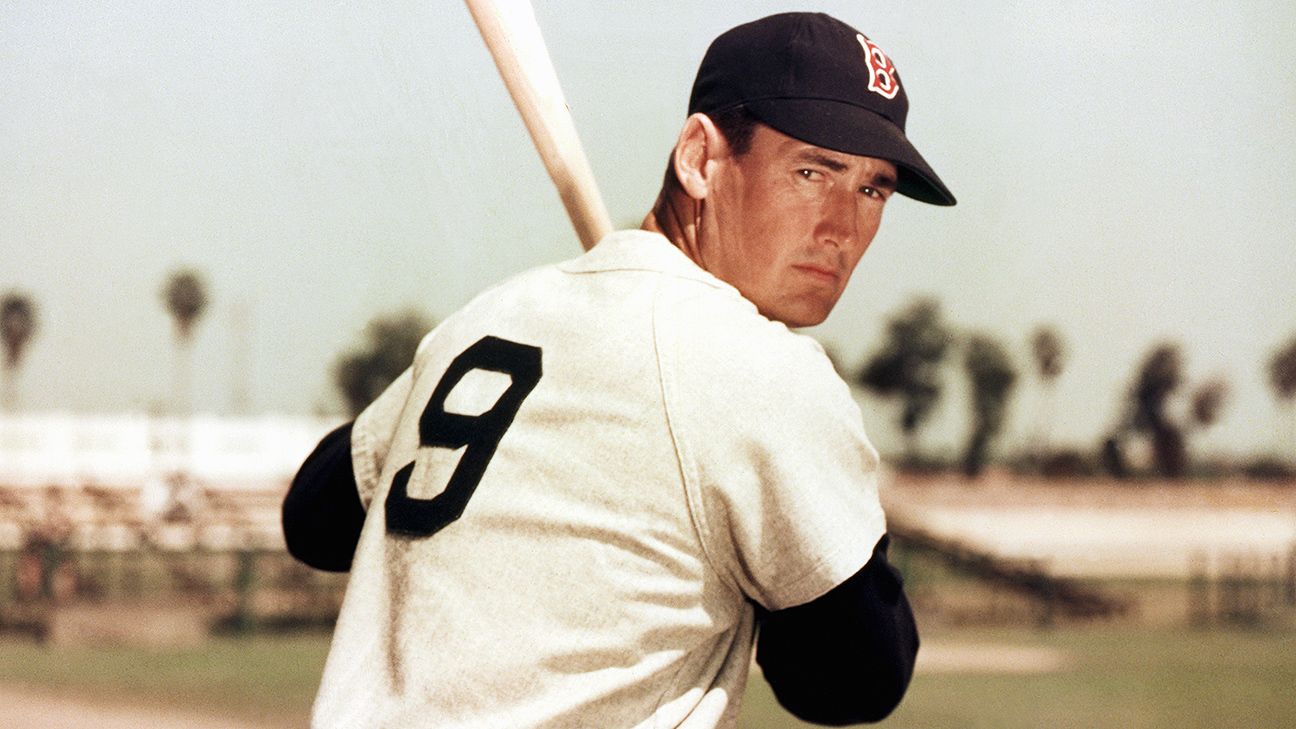


 Phone: (800) 737. 6040
Phone: (800) 737. 6040 Fax: (800) 825 5558
Fax: (800) 825 5558 Website:
Website:  Email:
Email: 






